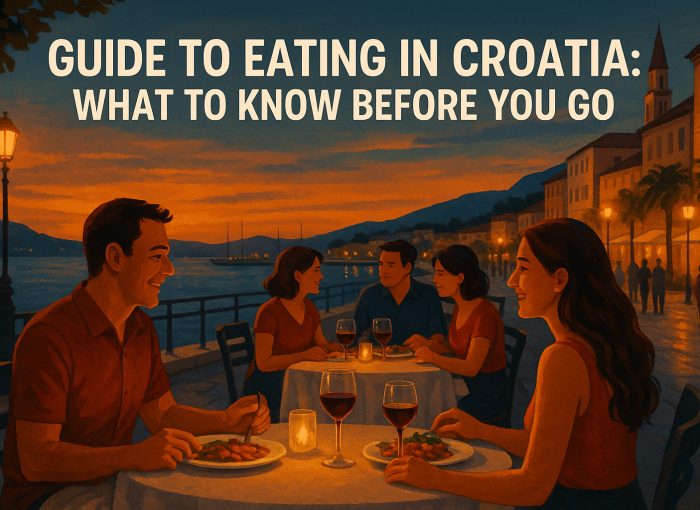Your complete guide to eating in Croatia: must-try dishes, local tips, and how to enjoy authentic food from the coast to the countryside.
Table of Contents
Croatia is a country made for food lovers. Here, eating isn’t just about fueling up; it’s about savoring life. From fresh seafood kissed by the Adriatic sun to hearty inland stews passed down through generations, Croatian cuisine is packed with flavor, history, and local pride.
Whether you’re sipping coffee for hours in a sunny square or stumbling upon a hidden konoba (tavern) in a quiet village, every meal is an experience. However, it can also turn into a bad and expensive experience, especially in tourist trap areas.
Ready to eat your way through Croatia? Here’s everything you need to know!
Croatia’s Flavors: An Overview of Regional Cuisine
Discover how geography, history, and culture shaped Croatia’s mouthwatering food traditions.
Croatia’s kitchen is a mosaic of its geography and history.
Along the Adriatic coast, Mediterranean flavors reign — olive oil, seafood, wild herbs, and lots of grilling. Think Italy, but with its own twist.
In the inland regions, you’ll find Austro-Hungarian and Ottoman influences: meat-heavy dishes, stews, pickled vegetables, and fresh-water fish.
Each area proudly showcases its unique specialties — and trust me, you’ll want to taste your way through all of them.
Don’t miss our guide to eating in Croatia too!
Savoring the Coast: Seafood and Mediterranean Magic
From grilled fish to truffles: the best dishes you can’t miss along Croatia’s dazzling coastline.
In Dalmatia, simplicity is key: the day’s freshest catch grilled over wood, seasoned only with olive oil, garlic, and a sprinkle of sea salt.
Don’t miss:
- Crni rižot: Black cuttlefish risotto — salty, briny, and utterly addictive.
- Pašticada: A slow-cooked beef stew in a rich wine sauce, often served with gnocchi.
- Octopus salad: Light, fresh, and perfect on a hot day.

In Istria, it’s all about truffles and pasta:
- Fuži with truffles: Fresh pasta with local truffles — pure decadence.
- Seafood stews: Slow-simmered in white wine and tomatoes.
- Olive oil and wine are practically sacred here — join a tasting if you can.
In Kvarner, you’ll feast on:
- Kvarner scampi: The best, sweetest scampi in the Adriatic.
- Cres lamb: Arguably Croatia’s most famous lamb, raised on wild island herbs.
Explore Croatian fish and seafood in more detail with our guide.
🎣 A Quick Note About Fish in Croatia
While Croatia’s coastline is famous for its seafood, most fish you’ll find in regular restaurants is actually farmed (uzgojena), not freshly caught from the sea.
Only the very best — and often priciest — restaurants serve true, wild-caught fish.

Tip:
If you want authentic, fresh-from-the-sea flavors without breaking the bank, go for small blue fish like sardines (srdela), picarels (giće), or anchovies (inčuni).
They are healthy, affordable, and always from the Adriatic Sea!
Inland Delights: Comfort Food and Hearty Meals
Subtitle: Taste the heart of Croatia with meaty stews, cheesy pastries, and cozy countryside flavors.
While the coast boasts Mediterranean lightness, inland Croatia is all about rich, comforting food — a direct reflection of its Central European roots.
Austro-Hungarian and Ottoman influences weave through the cuisine here, creating a hearty tapestry of flavors that feel like a warm hug.
Expect plenty of meat: pork, beef, and game, often slow-cooked into stews or roasted until tender. Sausages, smoked meats, and juicy schnitzels are staples on most menus, especially around Zagreb, Slavonia, and northern Croatia.
Cheese lovers, rejoice! The countryside offers an abundance of fresh cow’s and sheep’s milk cheeses, served simply or tucked into flaky pastries like the beloved štrukli — a baked or boiled dough filled with soft cheese, sometimes sweet, sometimes savory.
Meals often start with a warming soup (beef or chicken broth with noodles), and are followed by hearty mains like fiš paprikaš (spicy river fish stew), goulash, or plates piled high with roasted meats and potatoes.
Slavonia serves up the spice. Fiš paprikaš is a spicy river fish stew, best enjoyed with bread and a cold beer. Kulen is a spicy cured sausage packed with paprika.
Lika and Gorski Kotar are all about rustic mountain food:
- Lamb under the bell (peka): Slow-cooked in embers with potatoes.
- Forest mushrooms and game meats: In hearty stews or simply grilled.
Pair it all with a local beer, a glass of rakija (fruit brandy), or a robust Slavonian red wine for the full inland experience.
Eating inland is less about presentation and more about comfort, tradition, and generosity — where every meal feels like a family feast, whether you’re in a rustic village tavern or a bustling city restaurant.

Casual Classics: Croatia’s Everyday Meals
Ćevapčići, fries, fish platters and more: Croatia’s no-frills favorites that locals love.
When you’re hungry and don’t feel like overthinking your meal, Croatia’s casual classics have your back.
From the bustling city squares to tiny coastal villages, you’ll find a familiar lineup of simple, hearty dishes — the kind of everyday comfort food that locals crave after a long day.

At the top of the list? Ćevapčići — small, juicy minced meat sausages, grilled to perfection and usually served with a side of fries (pommes frites), flatbread, raw onions, and a dollop of ajvar (a smoky red pepper spread).
You’ll spot it everywhere: from seaside kiosks to family restaurants and roadside grills.
Meat platters are another crowd-pleaser, offering a mix of grilled pork chops, sausages, chicken, and sometimes even liver or skewers — perfect for sharing.
If you’re near the coast, swap the meats for a fish platter, featuring grilled whole fish, calamari, and shrimp, often simply dressed with olive oil and lemon.
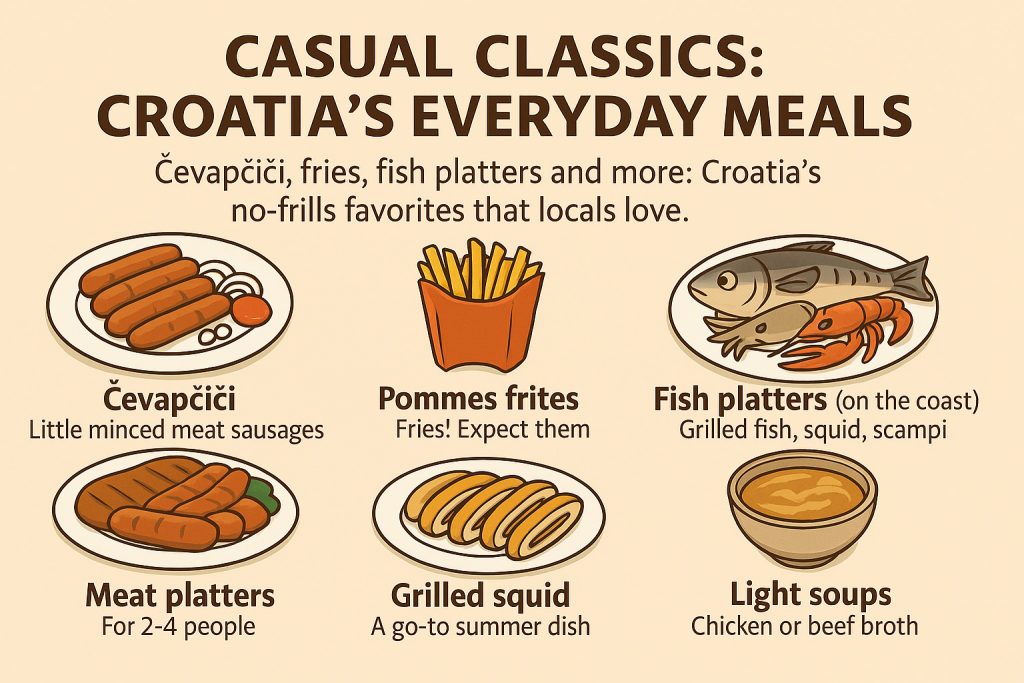
Pizza is also surprisingly good in Croatia, influenced by neighboring Italy. It’s often a safe and satisfying choice when you’re unsure what to order.
That said, don’t expect these casual meals to be the healthiest option. They’re usually heavy on meat, fried sides, and bread, and light on veggies.
But if you’re looking for something quick, filling, and easy to find, especially when you’re on the move, these no-frills favorites are the way to go.
🍴 Where to Eat in Croatia: From Local Taverns to Michelin Stars
Croatia’s dining scene has something for everyone — whether you’re craving a simple grilled fish by the sea or a multi-course tasting menu at a world-class restaurant. Here’s how the restaurant landscape breaks down:
🏡 Konoba (Traditional Tavern)
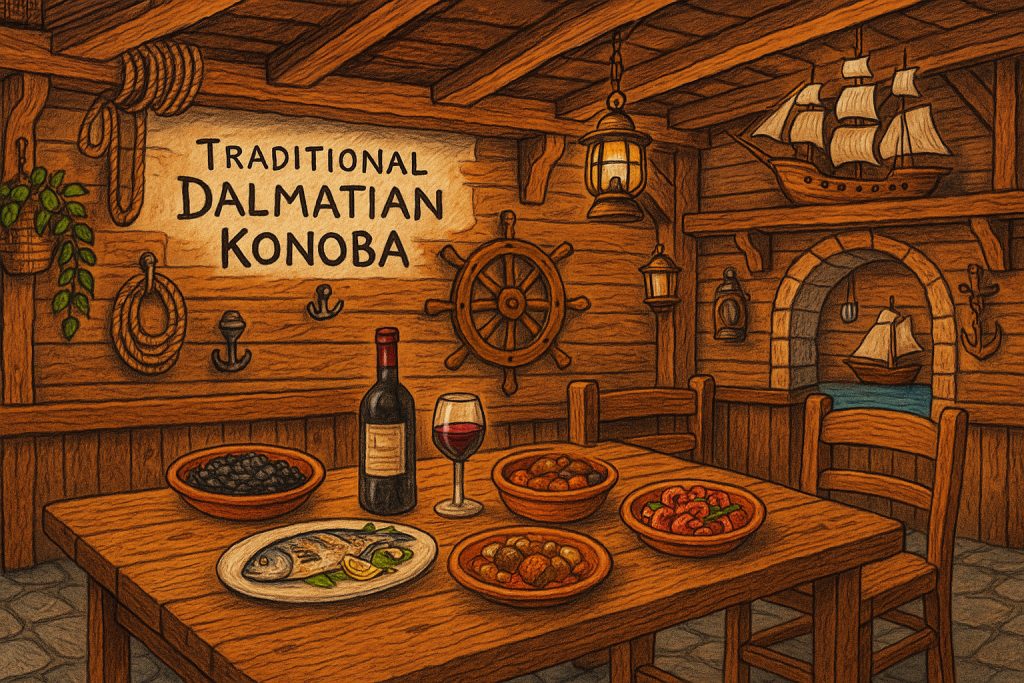
Konobas are rustic, cozy, and often family-run, offering an authentic, homey atmosphere that feels like you’re stepping into someone’s living room.
Menu:
Expect seasonal and simple dishes — grilled meats, fresh fish, octopus salad, hearty stews, and plenty of homemade wine flowing freely. It’s all about traditional flavors without any fuss.
Price Range:
Starters usually range between €5 and €10, while main dishes fall between €10 and €20. If you’re planning on having a full meal — a starter, main course, and a glass or two of wine — you can expect to spend around €20 to €35 per person.
Quality:
The quality is usually excellent, as long as you pick the right konoba. Ingredients are fresh and local, portions are generous, and seasoning is delightfully simple — think good olive oil, garlic, and a sprinkle of sea salt. Don’t expect fancy plating; the focus here is on honest, hearty food that speaks for itself.
Pro Tip:
Always look for konobas packed with locals and avoid places with laminated photo menus — that’s usually the best sign you’re about to have an unforgettable meal!
🍲 Daily Meal Spots: Gableci & Marenda
Affordable, filling, and surprisingly tasty — Croatia’s secret weapon for budget-friendly eating.
All over Croatia — especially in inland towns and along the coast — you’ll find low-key local restaurants or roadside diners offering quick, home-cooked meals around mid-morning to early afternoon. These are known as “gableci” in continental Croatia and “marenda” along the coast. Primarily aimed at locals, these meals are prepared early in the day and served until they run out, often by 1 PM. They’re not fancy, but they’re fresh, convenient, and often delicious.
Menus are usually handwritten or on a chalkboard outside, changing daily based on what’s in the kitchen. Typical dishes include gulaš (meat stew), grah s kobasicom (bean stew with sausage), ćevapčići, grilled meats with mashed potatoes or rice, and seasonal specialties like stuffed peppers or sarma. You’ll often get a soup and a main course for around €5–€9, making it one of the best value meals in the country.

These spots don’t usually have English menus, but staff are used to locals pointing or asking for “gablec” — so don’t be shy. If you’re road-tripping or exploring outside tourist hubs, this is a perfect way to eat like a Croatian, without spending much or wasting time.
Pro tip: Gableci and marenda meals are served fast, perfect for a quick but satisfying lunch. Just get there early — when it’s gone, it’s gone!
🍖 Roštilj (Grill House)
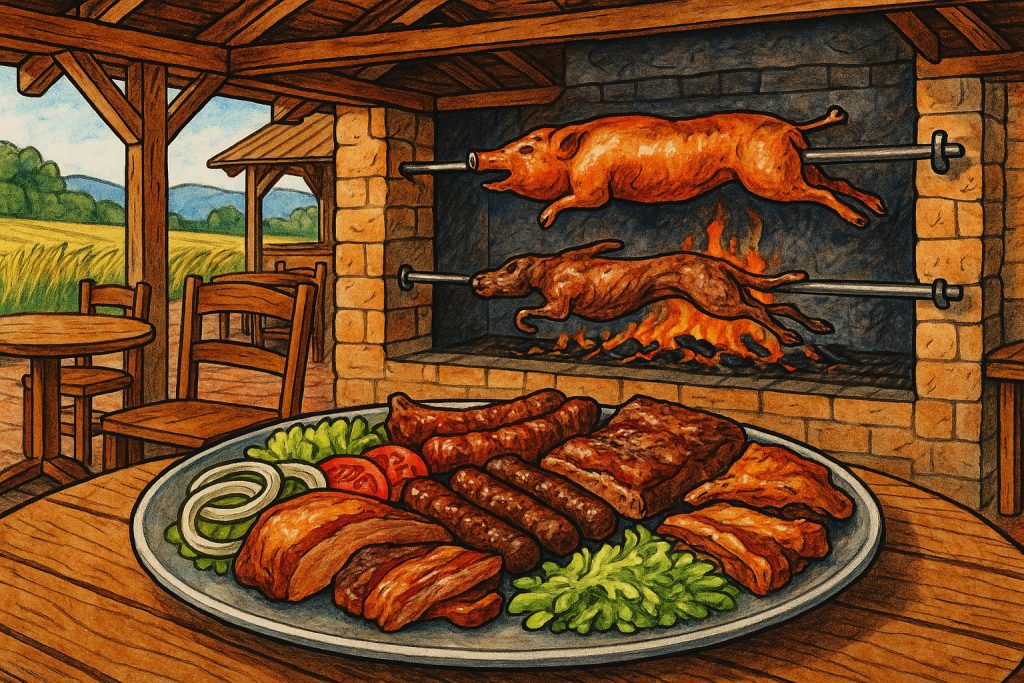
These spots are casual, no-frills, and an absolute paradise for meat lovers. Expect a laid-back atmosphere where the focus is entirely on the food, not the decor.
The menu usually revolves around grilled favorites like ćevapčići, pork chops, and mixed meat platters piled high with juicy cuts. Fries are the go-to side, and depending on where you are, you might also find some grilled fish or squid options sneaking onto the menu.
Ćevapčići plates typically cost between €6 and €10, while a generous mixed grill platter for two usually runs around €20 to €30 — making it a fantastic choice if you’re hungry and watching your budget
Meat dishes are reliably good almost everywhere. If you’re ordering seafood, though, freshness becomes more important and can vary from place to place. Overall, it’s a great option when you want a hearty, satisfying meal without spending too much.
Pro Tip:
If you spot a charcoal-fired grill in action, that’s your sign — the flavor is absolutely worth it!
🍝 Casual Seafront Restaurants
Casual seafront restaurants are all about relaxed terraces along the promenade (riva) or marina, where you can enjoy the sea breeze and watch the boats drift by.
You’ll find a mix of grilled fish, seafood risottos, squid dishes, pasta, and pizza — perfect for a leisurely lunch or a laid-back dinner by the water.
Pasta and risotto dishes usually cost between €10 and €15, while fish dishes vary from €15 to €30 depending on the type and weight. If you’re planning a full meal with a starter, main course, and a drink, you’re looking at around €25 to €40 per person.
In touristy areas, quality can be hit or miss. It’s a good idea to choose restaurants that proudly display fresh fish, offer local wines, and have handwritten daily specials. Also, be cautious — some places overcharge if you don’t check the fish weight beforehand, so it’s always smart to ask.
Pro Tip:
When it comes to seafood, the simpler the preparation — like a basic grill with a drizzle of olive oil — the better the quality tends to shine through.y is.
🍷 Wine Bars & Modern Bistros
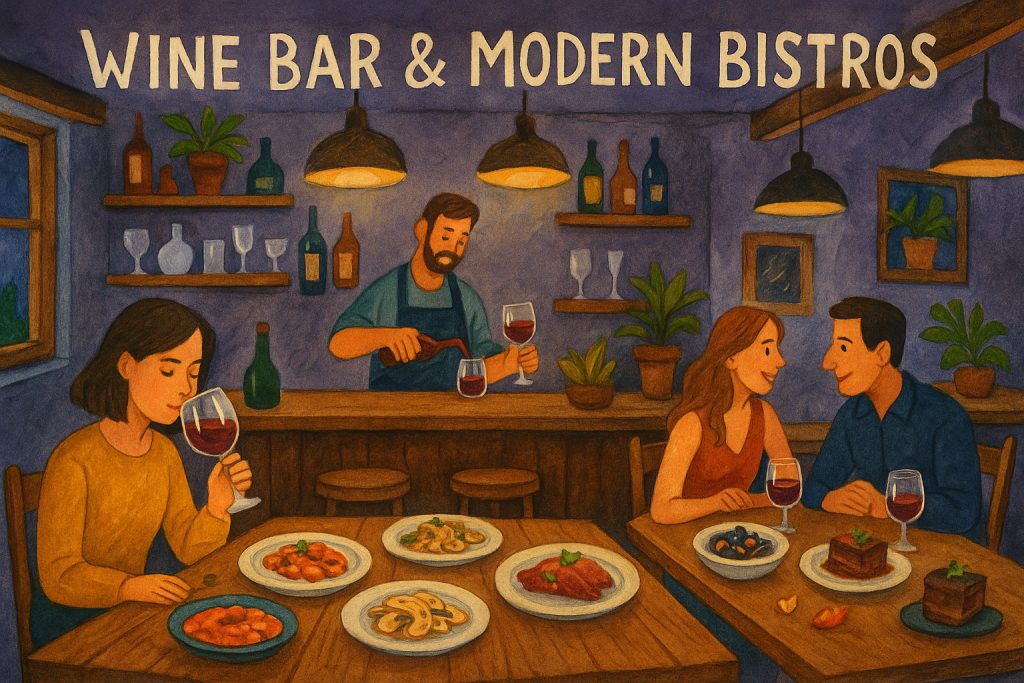
Wine bars and modern bistros in Croatia have a trendy, cozy feel, often combining stylish decor with a focus on local ingredients given a modern twist. These are the kind of places where you can settle in for a long, relaxed evening of grazing and sipping.
The menus usually feature tapas-style small plates, truffle pastas, creative seafood variations, and inventive desserts — perfect for those who love trying a bit of everything.
Small plates typically range from €7 to €15 each, while some places offer tasting menus priced between €30 and €50. A glass of good local wine will usually set you back between €3 and €8.
The quality is usually fantastic, especially if you pick places that focus on local sourcing and seasonal produce. These spots are a dream for foodies who want to taste a wide variety of flavors without committing to just one huge main course.
Pro Tip:
Always ask the staff for wine pairing suggestions — they usually have great local recommendations that will elevate your whole meal.tions — Croatian sommeliers are often super passionate and happy to chat.
🌟 Fine Dining & Michelin-Starred Restaurants
Fine dining and Michelin-starred restaurants in Croatia offer an elegant, creative, and experience-driven atmosphere. These are places where every detail — from the table setting to the view — is carefully curated to create an unforgettable evening.
Expect multi-course tasting menus that highlight local ingredients with a luxurious, high-end twist. Artistic plating, bold flavors, and inventive combinations are the norm, with dishes often inspired by the seasons and Croatia’s rich culinary traditions.
Tasting menus typically start from around €70 to €150 per person, depending on the restaurant and the number of courses. Wine pairings, often highly recommended, usually add an additional €40 to €100 to your meal.
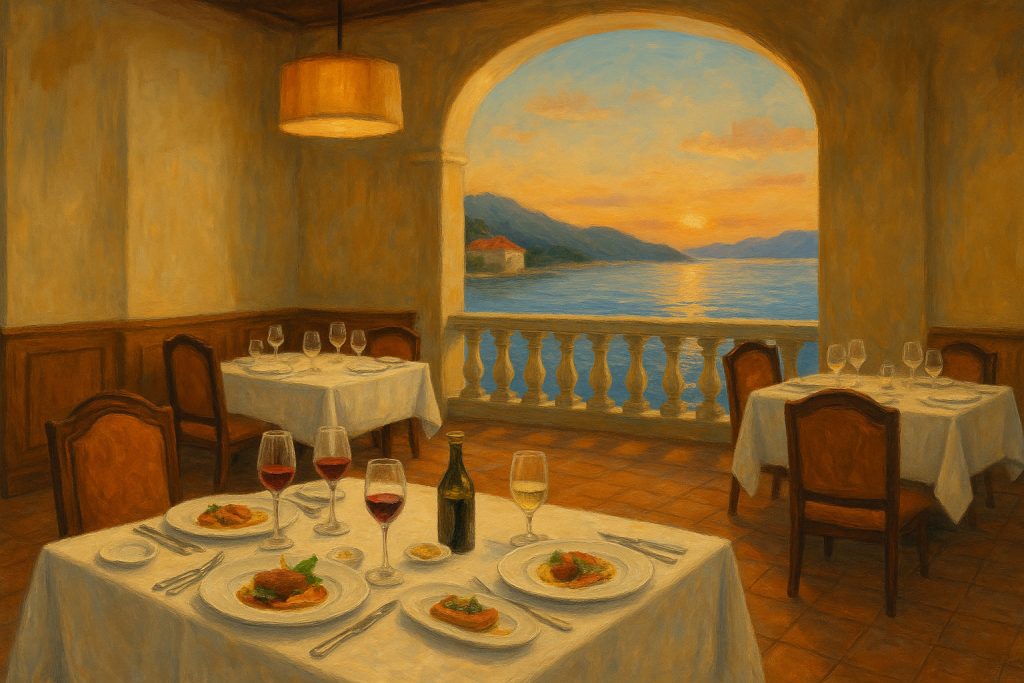
Michelin-starred restaurants in Croatia include:
1. Pelegrini (Šibenik) ⭐️ Michelin star: Croatia’s culinary darling — fine dining rooted in Dalmatian tradition, located next to a UNESCO cathedral. ⭐️ Try: Seasonal tasting menu with wine pairing.
2. Noel (Zagreb) ⭐️ Michelin star: Elegant and urban fine dining — perfect for a sophisticated city dinner. ⭐️ Try: 5- or 7-course tasting menus, vegetarian options available.
3. LD Restaurant (Korčula) ⭐️ Michelin star: Stunning sea-view setting with creative Mediterranean tasting menus. ⭐️ Ideal for a sunset splurge.
4. Monte (Rovinj, Istria) ⭐️ Michelin star: Croatia’s very first Michelin-starred restaurant, right under the beautiful Church of St. Euphemia. ⭐️ Try: Full tasting menu for a true experience.
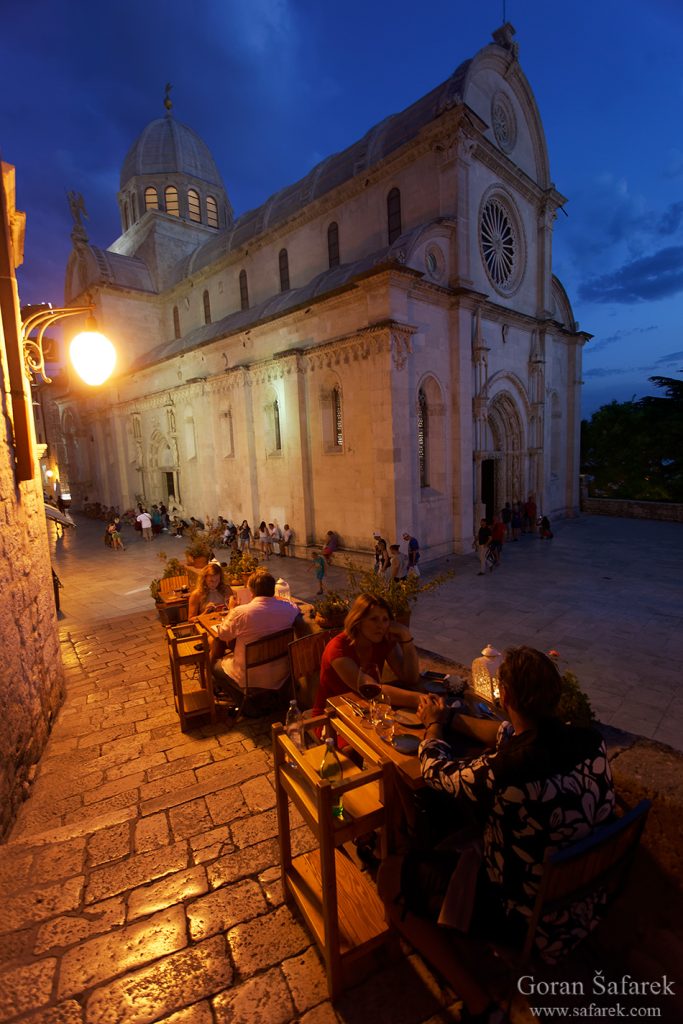
Pro Tip:
Reserve early (especially June–September), and always double-check if tasting menus have vegetarian options if needed.
Quick Summary of Restaurant Types and Prices:
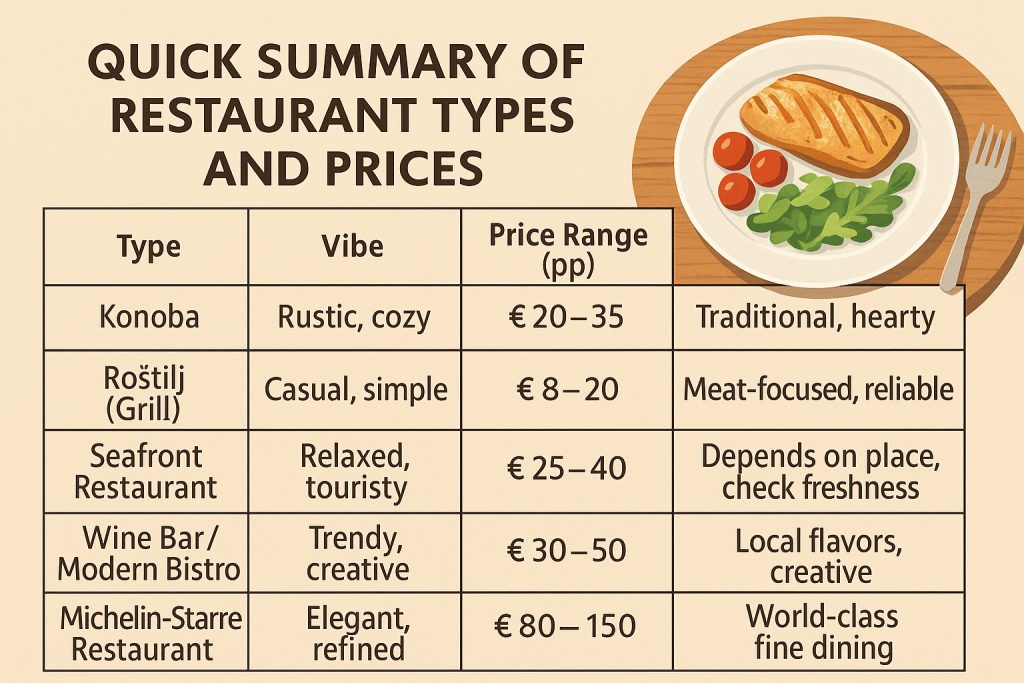
🍷 Extra Tip:
If you’re not super hungry, sharing plates is totally normal in Croatia — and it’s the perfect way to sample more flavors without blowing your budget!
💰 Tipping in Croatia
Tipping in Croatia isn’t mandatory, but it’s certainly appreciated, especially in restaurants. If you’re happy with the service, it’s polite to simply round up the bill or leave around 10% as a tip. In more casual places like cafés, bars, or small konobas, rounding up the amount is perfectly fine.
In higher-end restaurants or if you’ve received exceptional service, a slightly more generous tip will always be warmly received. Just hand the tip directly to your server or leave it on the table — either way, it’s a small gesture that goes a long way.
Eating Like a Local in Croatia: Customs, Tips, and Etiquette
How to blend in, eat well, and enjoy Croatia’s relaxed dining culture like a true insider.
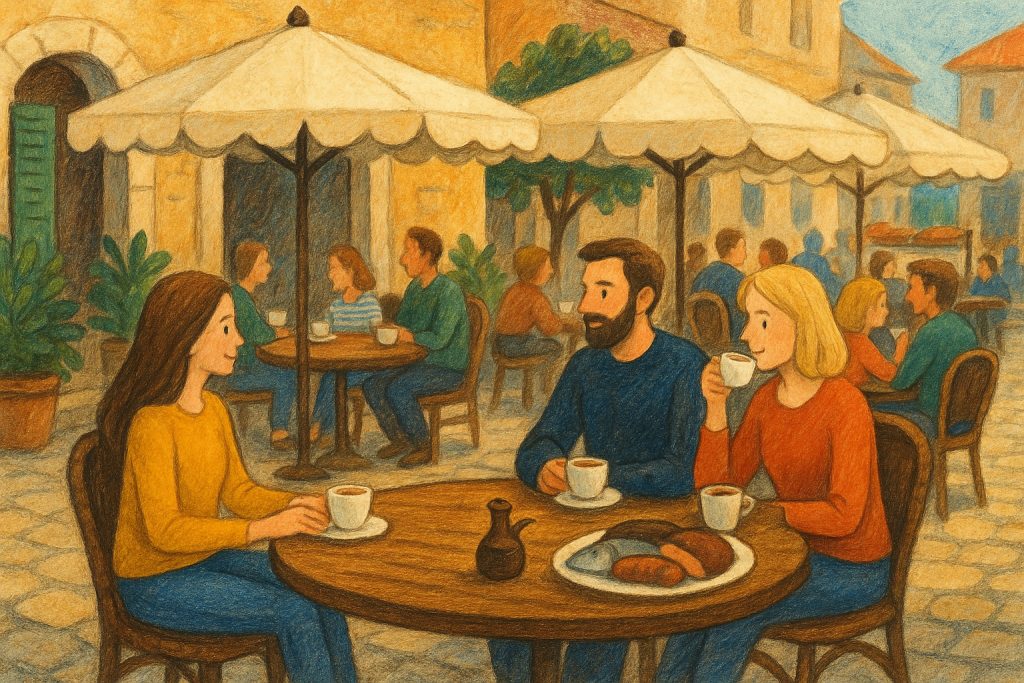
In Croatia, coffee is more than just a drink — it’s a ritual. A single cup can last up to two hours as friends catch up, people-watch, and enjoy the slow rhythm of the day. There’s no rush here; lingering over your coffee is part of the culture.
You’ll also hear about marenda, a mid-morning snack or light lunch that’s especially popular along the coast. It’s the perfect way to refuel before the full lunch experience later on.
Lunch is considered the main meal of the day in Croatia, often more important than dinner. It’s when families gather for hearty dishes, and afterward, many people opt for a much lighter dinner or just a snack.
If you see bread and olive oil arrive at your table without ordering it, don’t be surprised if a small cover charge appears on the bill — usually less than a euro. It’s a normal part of the dining experience.
Avoiding Tourist Traps: How to Find Authentic Food
Simple tricks to spot real konobas, avoid overpriced menus, and eat where the locals do.
If you want an authentic Croatian dining experience, a few simple tricks can help you find the real konobas and avoid tourist traps.
Menus filled with too many glossy photos are usually a warning sign. Real local spots tend to keep it simple, often using handwritten chalkboard menus that highlight the day’s specials — a great sign that the food is fresh and seasonal.
One of the best ways to find a good place is to ask locals where they eat, not where they recommend tourists go. You’ll often be pointed toward small, cozy konobas tucked away from the main streets.
Visiting morning markets is another insider tip. It’s where you’ll see what’s truly fresh that day — and the best konobas and restaurants shop there too.
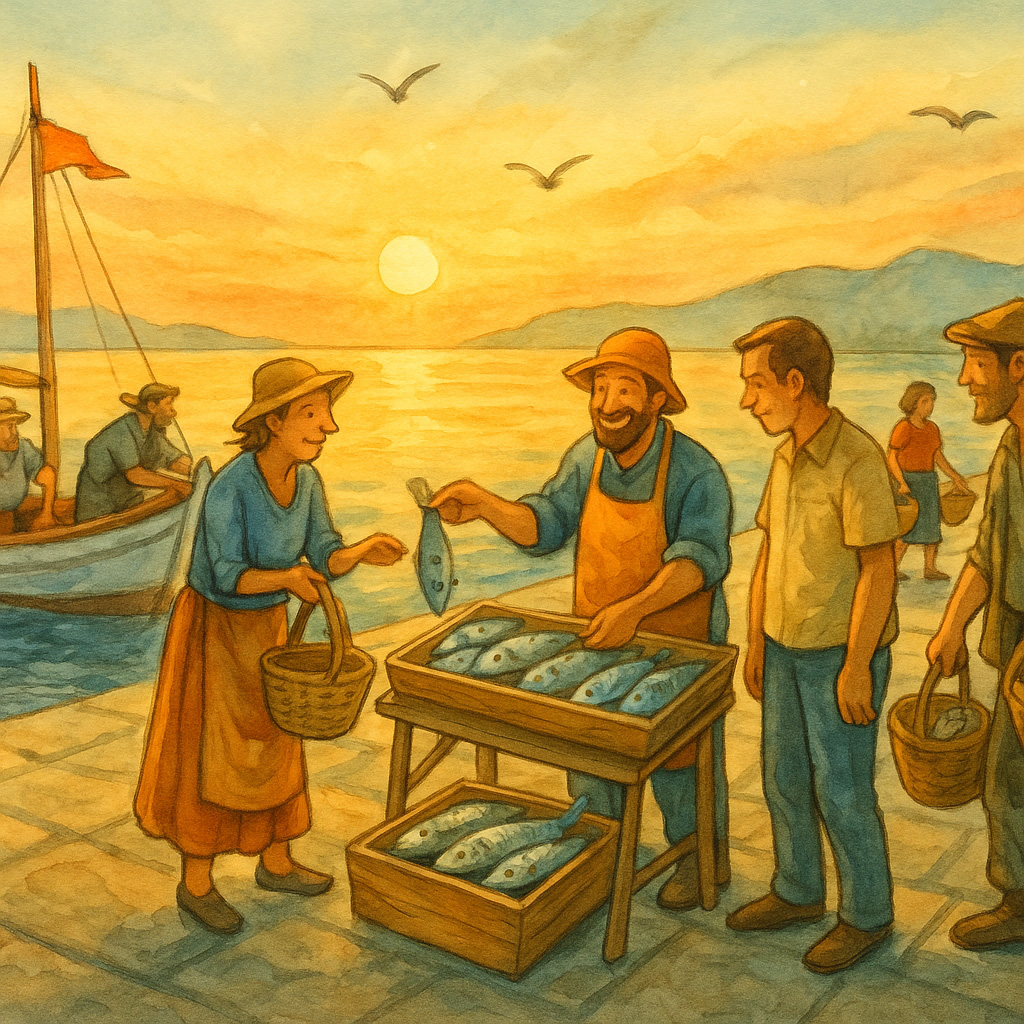
Finally, timing matters. Locals typically eat lunch between 12 and 2 p.m., and by 4 p.m., many kitchens close for a break before reopening for dinner service. Eating early gives you the freshest experience and avoids the awkward mid-afternoon gap when many places shut down.
Wine, Olive Oil, and Spirits: A Croatian Liquid Feast
Sip your way through Croatia’s vineyards, olive groves, and family-run distilleries.
Croatia’s wine scene is world-class yet still under-the-radar:
Croatia’s wine scene is world-class yet still wonderfully under-the-radar. Exploring it feels like discovering a secret that’s been hidden in plain sight.
Among the top local varieties to try are Pošip, a crisp white from Dalmatia; Malvazija, a fresh and aromatic white from Istria; and Plavac Mali, a bold, full-bodied red also from Dalmatia. These wines pair beautifully with the country’s seafood, meats, and rich Mediterranean flavors.
Don’t miss a taste of Prošek, a traditional Dalmatian dessert wine — just be careful not to confuse it with Italian Prosecco, as they are completely different! Prošek is sweet, rich, and often enjoyed slowly after a meal.
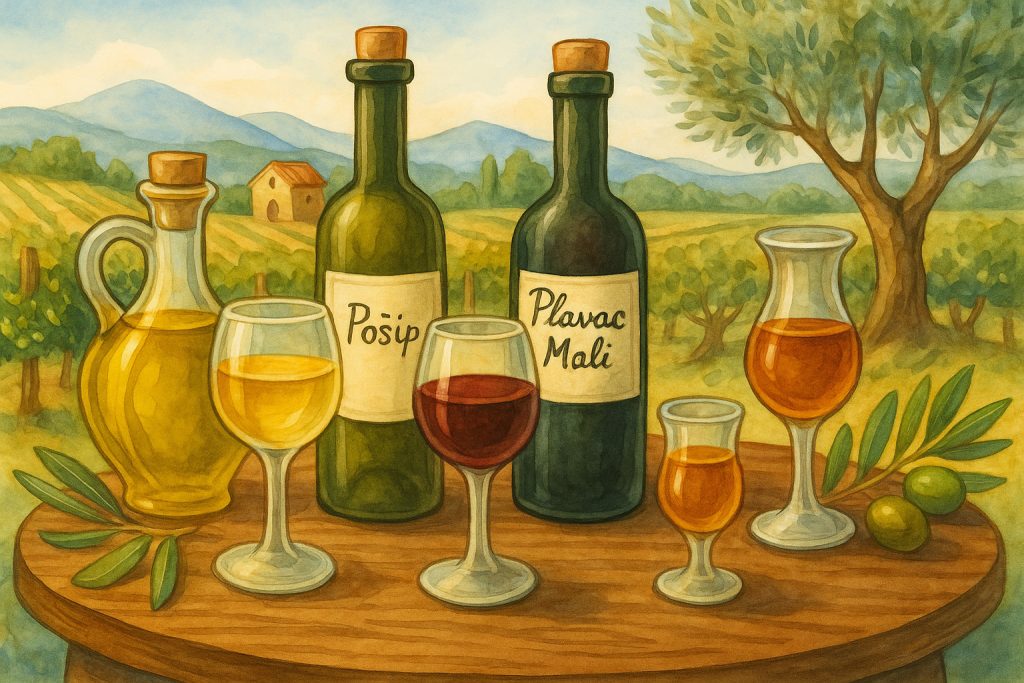
Olive oil lovers are in for a treat too, especially in Istria, where the oils are internationally award-winning. If you get the chance, opt for a tasting flight — the depth of flavor and variety might surprise you.
And for a truly local experience, try a small glass of rakija, Croatia’s beloved fruit brandy, usually made from plum, pear, or quince. It’s often served at the beginning of a meal as a welcoming gesture — but sip carefully, rakija packs quite a punch!
Sweet Tooth in Croatia: Must-Try Desserts and Pastries
Fritule, kremšnita, rožata and beyond: the dreamiest Croatian desserts you’ll want to try.
If you’re craving something delicious, start with fritule, tiny fried doughnuts often dusted with powdered sugar and sometimes flavored with a hint of rum or citrus. They’re a festive treat, especially around holidays and coastal towns.
Another must-try is kremšnita, a creamy custard slice that’s become iconic in places like Samobor and Zagreb. Light, sweet, and impossibly fluffy, it’s the kind of dessert you can’t resist going back for.
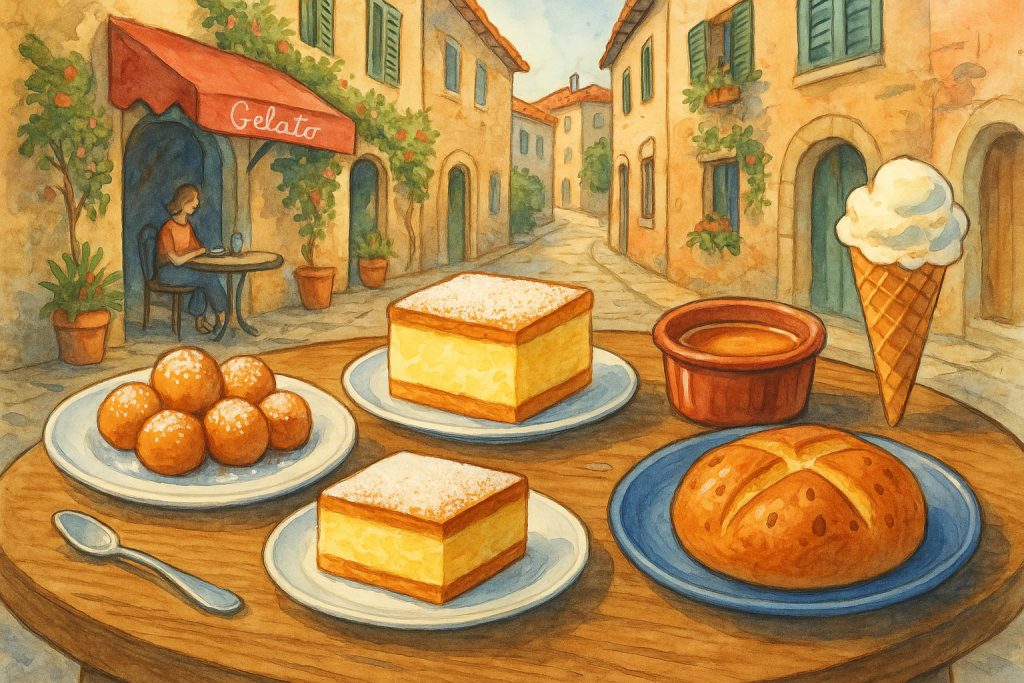
Down south in Dubrovnik, rožata takes center stage — a silky caramel flan similar to crème caramel, but with a distinct Dalmatian touch thanks to a splash of local rose liqueur.
If you’re visiting during Easter, keep an eye out for pinca, a rich, slightly sweet bread traditionally eaten to celebrate the holiday, often scented with citrus peel and a touch of rum.
And of course, gelato along the coast deserves a special mention. Croatian gelaterias take their craft seriously, offering creamy, flavorful scoops that easily rival Italy’s best — so don’t hesitate to sample freely as you wander seaside towns.
Foodie Souvenirs: What to Bring Home from Croatia
The ultimate guide to shopping for truffles, wines, oils, and tasty treats — without getting scammed.
Perfect edible souvenirs:
- Istrian truffle products (choose reputable shops, not tourist kiosks).
- Dalmatian wines and olive oils.
- Fig jam, lavender honey, and artisan rakija. Tip: Avoid “gift packs” in tourist zones — head to local delis or direct producers instead.
Seasonal Food Guide: What to Eat and When
A month-by-month look at Croatia’s freshest, most delicious seasonal specialties.
In spring, Croatia celebrates the arrival of fresh flavors with wild asparagus dishes popping up on menus everywhere. Easter brings traditional lamb feasts, with slow-cooked meats taking center stage at family tables and konobas alike.
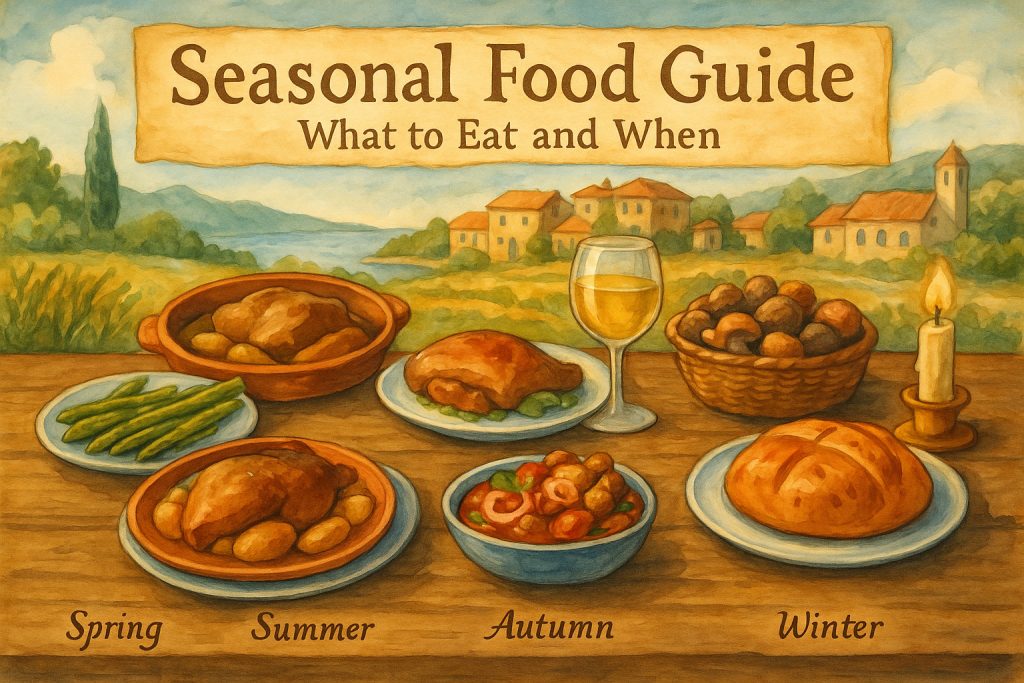
Summer is all about simplicity and freshness. Grilled fish, light octopus salads, and chilled glasses of local white wine dominate seaside menus. Meals are lighter, fresher, and often enjoyed outdoors under the sun or by the sea.
As autumn rolls in, the country turns to earthier flavors. It’s truffle hunting season, especially in Istria, and markets fill with wild mushrooms. Hearty stews and rich, slow-cooked dishes return to the table, perfect for cooler evenings.
Winter brings festive comfort food. Christmas specialties like sarma — cabbage rolls stuffed with minced meat and rice — roasted meats, and sweet breads fill homes and restaurants with cozy, nostalgic aromas. Meals become heavier and more celebratory, perfect for gathering around the table with family.
📚 Conclusion: Your Croatian Culinary Adventure Awaits
Follow your taste buds and discover Croatia’s incredible world of food — one bite at a time.
No matter where your journey takes you — from seaside villages to sleepy inland towns — Croatia’s food will be waiting to surprise you with warmth, heart, and deliciousness.
Bon appétit — or as the locals say, Dobar tek! 🍷✨
